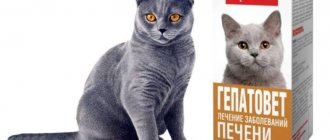Hepatosis is a group of liver diseases that are associated with metabolic disorders and are expressed in tissue degeneration and degeneration of liver cells. The liver is an important protector of our body from toxins and often takes the hit. She can independently regenerate and perform many amazing functions in the body.
Dystrophic changes affect the functional activity of the liver, and subsequently lead to its complete degeneration. Hepatosis is similar in nature to an inflammatory disease - hepatitis, but does not have signs of an inflammatory reaction.
Causes of hepatosis
- The main reason for the development of fatty degeneration is poor quality food. This disease has received especially great development recently. When many owners began to give preference to untested food of dubious quality.
- Molds – they have a toxic effect on the liver in the cat’s body; they can be ingested with spoiled or expired food.
- Obesity – especially liver problems are aggravated in older pets.
- Diabetes.
- Plant poisons (saponins and alkaloids).
- Infectious viral processes in the gastrointestinal tract and general septic processes.
- Liver diseases - cholangitis, blockage of ducts, abnormalities in the development of the portal vein system.
- Pancreatitis.
- Thyroid diseases.
- Lack of vitamin B12.
Most often, the disease is idiopathic (unexplained) in nature. Cats over 10 years old and overweight are exposed to it.
Amyloidosis is systemic in nature and in more than 90% of all cases of the disease occurs in Abyssinian cats. Basically, the disease has a hereditary type of transmission, but it can also develop against the background of inflammatory or proliferative diseases.
Symptoms of hepatosis
In acute fatty hepatosis, symptoms develop rapidly.
First, the symptom of general intoxication increases - the cat becomes lethargic, has a decreased or absent appetite, and does not show interest in others.
The second symptom is increasing jaundice.
Subsequently, due to an increase in toxic effects on the body and the accumulation of amine, ammonia and bile acids, it leads to hepatic coma.
Fatty hepatosis with a chronic course is characterized by:
- Complete refusal to eat and sudden weight loss.
- Jaundice - clearly manifests itself on the mucous membranes and the inside of the ears.
- Lethargy.
- Digestive disorders - vomiting bile, diarrhea or constipation.
- Salivation.
- Hepatic encephalopathy - when the brain is damaged by toxins, seizures and a general decrease in functioning occur.
- Thinking disorder.
- Ventroflexion of the neck is the inability to raise the head due to muscle weakness.
- Enlarged liver.
Amyloidosis affects not only the liver, but also the functioning of the heart and kidneys. The animal will be pale (assessed by the oral mucosa), the abdomen will be enlarged due to swelling, enlarged liver and ascites. There is jaundice and pain in the joints, which causes stiffness of movement and decreased physical activity.
Prevention of liver disease in cats
The most common liver pathologies in cats include hepatitis, cirrhosis, lymphocytic, neutrophilic cholangitis, which are included in the general group of cholangitis syndrome in cats, cancer and other ailments.
The pathology is characterized by damage to the bile ducts as a result of infection with pathogenic bacterial flora. Experts suggest that the source of infection is the intestines, but the etiology of the disease is not completely clear.
The pathology usually manifests itself acutely - the animal vomits repeatedly, the mucous membranes and skin turn yellow, there is general malaise and signs of intoxication - decreased activity and appetite, a lethargic state.
Young individuals are susceptible to the disease. Treatment leads to complete recovery within one to one and a half weeks. Relapses are observed in rare cases; chronicity of the disease is not typical.
Unlike neutrophilic, it is not associated with an infectious process. Experts suggest that a disorder of the immune response plays a major role in the pathogenesis of the disease. Most often, middle-aged and elderly animals are susceptible to pathology.
The resulting autoimmune complexes affect the bile ducts, resulting in a gradual increase in liver size, disruption of its function, and accumulation of ascitic fluid in the abdominal cavity. In the terminal stage, the pathological process also involves the liver parenchyma. There are high risks of transition of neutrophilic cholangitis to cirrhosis.
Hepatic lipidosis
Hepatic lipidosis is a disease caused by the deposition of lipids in hepatocytes. Fatty liver is manifested by dyspeptic disorders - nausea, vomiting, stool disorders develop, and the animal refuses to eat for a long time. Jaundice may appear.
Severe liver failure develops in the absence of adequate therapy. In this case, the cat exhibits signs of depression of the central nervous system - the animal’s behavior changes, lethargy and increased salivation are noted, and an unusual tilt of the head may appear.
Poisoning
Food poisoning, as well as toxic substances, can occur, for example, while walking, when an animal eats food from the ground or from a trash can.
Poisoning with salts of heavy metals, industrial compounds and other toxic substances can lead to the formation of hepatitis, cirrhosis and death of the pet.
Hepatitis
Hepatitis is an inflammation of the liver tissue, in which there is no violation of its architectonics. The etiological factor is infectious agents, as well as poisoning by toxic compounds.
Pathogenesis consists of infiltration of the liver with viral metabolites, bacterial waste products or toxins, resulting in local inflammation of the tissue. Massive poisoning can lead to the development of cirrhosis.
Symptoms are usually represented by yellowing of the mucous membranes and skin, nausea, vomiting, abnormal stool, and general poor health of the animal.
Hepatosis
Develops due to the accumulation of lipids in the liver. Hepatosis can occur against the background of existing pancreatitis, cholecystitis and other ailments. Most often, the fatty form occurs, less often - the pigmented form, in which the metabolism of bilirubin is disrupted.
The pet experiences dyspeptic disorders, loss of appetite and weight, and a depressed state.
Cirrhosis
Cirrhosis is a chronic liver disease in which a structural disorder of the organ’s architecture occurs and the formation of regenerated nodes against the background of fibrosis, that is, replacement of the connective tissue parenchyma. The disease is characterized by a severe course that cannot be treated. The disease, as a rule, develops against the background of hepatitis, which can occur due to a lack of vitamins, poor nutrition, toxin poisoning, the presence of stones in the bile ducts, and helminth infestation.
Liver cancer
Cats are susceptible to cancer. Liver cancer often develops. The origin of atypical tumor cells can originate from both the hepatocytes themselves and the bile ducts and other structures of the liver. Most often, malignant liver tumors are metastases, and their introduction is possible both hematogenously and lymphogenously. The disease is characterized by a malignant course that ends in death.
Helminthiasis
Helminthiasis is a group of infectious diseases caused by parasitic worms. There are a large number of helminths that can infect the internal organs of cats. The most favorite habitat is the liver. Invasion of an organ by parasites leads to the gradual destruction of its structure. Without taking medications, liver cirrhosis develops.
Cats are susceptible to infection by Leptospira bacteria. As a result of infection, leptospirosis develops. The disease affects the liver and other internal organs. Infection occurs through contact with other animals and their biological secretions.
The clinical picture is represented by hepatomegaly, ascites, but, as a rule, there is no jaundice.
We suggest you read: Vitamins for land turtles and red-eared turtles
In most cases, pathologies occur without any signs, so liver disease in cats, symptoms and treatment of the disease can only be determined by an experienced veterinarian.
Diseases of the organ have similar symptoms to ordinary illness or poisoning, and the owner of the animal is not always able to recognize liver disease in cats in time and seek help from a specialist.
The owner must take his pet to the veterinarian if symptoms such as:
- loss of interest in food;
- lethargy, apathy;
- weight loss;
- yellowness of the mucous membranes;
- vomiting, diarrhea;
- enlargement of the abdominal cavity (ascites);
- dark urine and light feces;
- skin itching;
- strong thirst;
- poor blood clotting;
- pain in the liver area.
The most common sign of liver disease is jaundice. Yellowing of the mucous membranes, and sometimes the skin, signals that the disease has become serious.
Very often the liver is greatly enlarged in size, and from the outside it seems that the right side of the animal seems to be sticking out.
Diagnosis of liver diseases in cats is carried out using laboratory and instrumental methods:
- General analysis of urine and blood. If there are problems with liver function, the level of bilirubin in the blood will be elevated.
- Specific blood test. Allows you to determine the level of bile acids produced by a parenchymal organ.
- Ultrasound examination. Able to assess the size of the liver and see whether there are structural changes in the tissues of the organ. Ultrasound can detect the disease at an early stage.
- X-ray. Just like ultrasound, it helps to assess the external and internal condition of the liver.
- Biopsy. It is the most accurate procedure for diagnosing organ diseases. A piece of liver tissue is removed using a long needle inserted into the abdominal cavity. This manipulation is performed under general anesthesia and only for those cats that do not have problems with blood clotting.
After carrying out all diagnostic measures and receiving the results, the doctor prescribes the necessary treatment for the sick patient.
There are many parenchymal organ pathologies found in animals. Some diseases are diagnosed most often, while others occur extremely rarely. The most common liver diseases in cats are:
- hepatitis;
- hepatosis (liver degeneration);
- neutrophilic and lymphocytic cholangitis;
- poisoning;
- carcinoma (malignant tumor);
- hepatic lipidosis;
- cirrhosis.
Cats are no less susceptible to cancer than other animals. Tumors affecting the liver can develop either directly in the organ itself or penetrate into it from other systems of the body.
A tumor such as carcinoma usually affects the bile duct of the liver. Basically, cancerous tumors of the organ occur in older animals and are the result of metastasis of cancer pathologies in other parts of the body.
In very rare cases, the tumor develops from hepatocytes.
Liver cancer in cats is virtually untreatable, but chemotherapy can significantly slow the growth of tumors.
Most often, cats suffer from dystrophy (hepatosis of the liver in cats), various toxic damage to the organ caused by exposure to poisons and harmful substances, and the penetration of infectious agents that provoke hepatitis.
Feline liver diseases always cause serious harm to the animal’s body and are not subject to effective treatment in all cases.
As a rule, the life of a cat can be extended if its owners promptly paid attention to the suspicious symptoms that appeared in their furry pet.
Some diseases, in the absence of competent assistance from a veterinarian, quickly lead to liver or kidney failure.
Before starting liver treatment in cats, it is necessary to accurately establish the root cause that provoked the disease of the parenchymal organ. For each disorder, therapy is selected individually:
- Treatment of neutrophilic cholangitis requires the use of powerful antimicrobial drugs with a broad spectrum of action. A sick animal requires a special diet that includes easily digestible food. Feed the cat often and in small portions.
- Treatment of lymphocytic cholangitis requires anti-inflammatory drugs, corticosteroids and immunosuppressants.
- Hepatic lipidosis is difficult to treat. First, it is necessary to establish the cause of the disease and cure it. Sick animals are prescribed supportive care and a special diet. The cat is fed through a tube until the animal begins to eat on its own.
- In case of poisoning, it is important to remove toxins and poisons from the cat’s body. For this purpose, adsorbents and supportive therapy are used, and in some cases hemodialysis (blood purification) is prescribed.
- Treatment of infectious hepatitis includes the use of antibiotic therapy, vitamins B and C, antispasmodics, and glucose. Toxic hepatitis requires a special diet, sulfa drugs, vitamins, and choleretic drugs.
- Therapy for hepatosis is carried out using antibiotics, antispasmodics, glucose injections with ascorbic acid, antihistamines, and hepatoprotectors.
- Cirrhosis is incurable. The sick animal is on lifelong therapy, including potassium and calcium supplements, vitamins, choleretic and diuretics, and corticosteroids. Special medicated cat food is used to feed the animal.
We suggest you read: How to give Duphalight to cats
Diagnosis of hepatosis
For hepatosis, characteristic changes can be observed even when taking the simplest tests - general blood, urine and biochemistry.
In a general urinalysis, poikilocytosis (altered shape of red blood cells) is observed. Urinalysis shows elevated lipid levels.
In a biochemical blood test, increased levels of liver enzymes (ALT and AST), increased levels of bilirubin and alkaline phosphatase. In case of a dangerous life-threatening condition, a reduced potassium content may be observed.
X-rays are used to diagnose liver enlargement.
For detailed study - ultrasound.
Since with hepatosis it is difficult to distinguish the true cause, a fine-needle biopsy is taken to clarify the type of dystrophy. For accurate diagnosis, before the tissue sampling procedure, vitamin K is given by injection, intramuscularly, at least 12 hours before the start of the procedure.
With liver amyloidosis, inflammatory processes and signs of anemia are often observed in a general blood test. Liver enzymes and bilirubin will be within normal limits. There is an increased protein content in the blood and urine.
If there is pain in the joints, it is imperative to collect synovial fluid in which purulent inflammation can be diagnosed. There is an increased protein content in the cerebral fluid.
Prevention of liver disease in cats
When the first symptoms of liver disease appear in your pet, you should contact a veterinary clinic. The specialist first conducts an external and physical examination. At this stage, the presence of ascitic fluid, hepatomegaly, yellowness of the oral mucosa, eyes, and skin can be detected. Next, the veterinarian prescribes additional research methods.
- A clinical blood test in the presence of an inflammatory reaction in the body is characterized by leukocytosis and an increase in ESR.
- A biochemical blood test is aimed at determining the concentration of pigments, alkaline phosphatase and other criteria that may indicate the presence of liver disease.
- X-ray of the abdominal organs can reveal an increase in the size of the liver, changes in its contours, the presence of abscesses and other pathologies.
- Ultrasound accurately determines structural changes in the liver; in case of cirrhosis and other pathologies, it is possible to detect areas with increased echogenicity. In addition, the study allows you to estimate the size of the organ.
Treatment of the disease depends on the diagnosis. Determination of timing, dosage and choice of medication is carried out by a veterinarian.
For a bacterial infection, the veterinarian will prescribe a course of antibiotic therapy. The choice of drug, its dosage and duration of use is based on the type of pathogen.
If liver changes are detected due to autoimmune processes, it is advisable to prescribe glucocorticosteroids.
Each disease has its own characteristics and treatment. But regardless of the specific disease, the main ones are: diet, hepatoprotectors, antispasmodics/painkillers. Treatment is also supplemented with specific drugs for each specific disease. For example, for cholelithiasis, these are choleretic drugs, for cirrhosis, these are proteins (albumin), for hepatosis, symptomatic therapy, possibly blood plasma transfusion.
Diet is a must for liver diseases. At the moment, many food producing companies offer a wide range of preventive and therapeutic food for animals with liver diseases. Hepatoprotectors are the second prerequisite for the treatment of these diseases. Today in veterinary medicine there are various effective veterinary hepatoprotectors (Hepatovet, Hepatoject), which are convenient to dose and administer to the animal.
The main thing to remember is that it is better to prevent a disease than to treat it later.
Health to you and your pets.
- prevent poisoning of the animal;
- feed your cat quality food;
- prevent the formation of infectious and invasive diseases;
- Regularly vaccinate and combat helminths.
Liver diseases in cats are easier to prevent, since further treatment of the pathology is always complex and lengthy. It is important to provide the animal with quality care and concern, and always pay attention to the slightest changes in the pet’s health.
Treatment of hepatosis
First of all, in case of hepatosis, dehydration should be removed. To do this, ringer's solution or rheopolyglucin is administered. If vomiting persists, cerucal is recommended (0.5 mg per kilogram once every 8 hours, half an hour before meals).
Be sure to follow a diet. If a cat has anorexia, then forceful tube feeding is used. A nasogastric tube is usually placed. It can then be inserted through the esophagus or directly into the stomach. Owners should offer their cat regular food every day.
The diet should be high in calories and contain large amounts of protein. It is recommended to add vitamins B, E and fish oil.
During tube feeding, arginine must be added to prevent the occurrence of convulsive syndrome.
Lactulose is used as drug therapy, as well as metronidazole at a dosage of 7.5 mg per kilogram every 12 hours.
Amyloidosis is very difficult to treat and owners are immediately warned that a complete cure is impossible. Infusion therapy is mandatory, and in case of acute blood loss - intravenous transfusion.
In rare cases, surgical treatment is used - removal of liver lobes when extensive bleeding occurs.
Drug therapy for amyloidosis - colchicine is given to control the production of amyloid, but can cause side effects - vomiting, bloody diarrhea and suppression of bone marrow function.
Dimethyl sulfoxide - administered as a solution intradermally to dissolve amyloid and have an anti-inflammatory effect.
The veterinarian trains the owner on tube feeding, which can last up to six months, as well as how to care for the cat during treatment. She is recommended complete rest and avoidance of stressful situations.
Hepatosis in cats: causes, symptoms, complications, diagnosis, treatment, preventive measures
About 30% of all diseases (non-contagious) in cats occur in the liver.
This is the most important organ that performs a number of vital functions:
- ensuring metabolism;
- removal of toxins, waste, processed products coming from the digestive tract;
- protein and hormone synthesis;
- energy storage in the form of glycogen;
- blood purification.
If the liver is damaged, these functions cannot be fully performed, which causes disruptions in all body systems. Hepatosis is a liver pathology, manifested in metabolic disorders due to tissue degeneration, as well as degeneration or death of cells (hepatocytes). Dystrophic transformations suppress the normal functioning of the liver, leading to its complete degeneration.
Hepatosis is divided into 2 types:
- Fatty degeneration is the degeneration of healthy cells into adipose tissue.
- Amyloidosis is a consequence of impaired metabolism: “harmful” amyloid protein accumulates in the liver. The result is immune pathologies.
Veterinarians more often diagnose problems associated with fatty changes. The disorders occur in acute and chronic forms.
Saving on quality food, an unbalanced diet, a lack of vitamins and minerals, intoxication and helminth damage - all this causes a strong blow to the liver. Individually or together, these factors suppress the healthy activity of the organ, aggravating the situation and making it susceptible to disease.
Hepatosis in cats is caused by the following reasons:
- intoxication of the body with poisons (especially plant poisons after chewing grass), chemicals, medications (spoilt food with mold fungi getting into the stomach is common);
- sudden changes in diet (for example, a rapid transition from natural products to feed);
- changing the constantly consumed brand of food;
- hypervitaminosis (excess of vitamins, minerals);
- obesity;
- diabetes;
- infectious viral processes in the intestines;
- pancreatitis;
- malfunction of the thyroid gland;
- lack of vitamin B12;
- diseases of the liver, gall bladder (cholangitis, blockage of ducts, pathologies in the portal vein system).
The main place in the list of provoking factors is occupied by low-quality feed. Unscrupulous manufacturers include harmful additives in their ingredients, and buyers, trying to save money, are increasingly buying dubious, untested products.
Fatty degeneration is caused by prolonged fasting, stress, and malignant neoplasms of internal organs. Obese cats over 10 years of age are susceptible to pathology. Hepatosis in young cats is idiopathic in nature, when the exact cause cannot be determined.
Diagnosis and treatment
The first step in diagnosing liver diseases in cats: hepatosis and others is a general blood and urine test. The full range of tests consists of a bilirubin test, biochemistry, and liver biopsy.
Additionally, ultrasound and x-ray examination of the affected organ are prescribed.
In amyloidosis, synovial fluid from infected joints is examined, thereby identifying signs of purulent inflammation.
The disease is serious and requires responsible treatment. It is impossible to restore health using folk remedies alone, but such treatment is allowed along with medications and diet.
Begin by relieving symptoms of dehydration by administering saline, rheopolyglucin, Ringer-Locke solution or other rehydration fluids. If vomiting is present, antiemetic drugs are prescribed (Cerucal 0.5 mg per 1 kg of cat weight before meals every 8 hours).
Hepatosis involves a strict diet rich in protein. If a cat has anorexia, tube feeding is practiced (you should check with your veterinarian about the details for doing it yourself). Initially, a nasogastric tube is installed, then it can be fixed through the esophagus or directly into the stomach. When artificially feeding a cat, Arginine is prescribed against seizures.
A high-calorie diet with plenty of protein is recommended; fish oil and vitamins B and E are introduced into the diet.
Natural products of animal origin (low fat content) and premium ready-made dietary food are suitable for nutrition.
Buy wet types, or soak dry food in water before feeding your cat. This is done so as not to injure the throat and esophagus of a weakened, sick cat.
Feed your cat often (4-5 times a day), in small portions. Make sure that your pet receives at least half the amount of food that he ate before becoming ill.
On the first day after an attack, limit the cat’s food intake, feed it porridge with water for a week, and only after that introduce lean meats and minced meat into the diet. A decoction of corn silk has proven itself - a mild choleretic drink.
If the pet refuses to drink on its own, give 3 tsp. before every meal.
Lactulose and also Metronidazole are used as drug therapy at a dosage of 7.5 mg per kilogram every 12 hours. For amyloidosis, Colchicine is given to control amyloid production.
To dissolve the latter and to relieve inflammation, Dimethyl sulfoxide can be administered. Injections with vitamin C and glucose are administered to relieve symptoms of intoxication. Antispasmodics and antibiotics are prescribed to relieve pain. It rarely comes to surgical intervention.
Surgery to remove liver lobes is performed when there is extensive bleeding.
Complications
Many liver diseases in cats: hepatosis, hepatitis and others provoke a number of complications that occur in advanced cases or after improper treatment.
Owners of cats with hepatosis face exacerbations of:
- hemorrhage;
- liver and kidney failure;
- infectious processes;
- coma.
Veterinarians say that due to a late appointment, it will not be possible to completely cure the cat; complications may result in death.
Disease Prevention
Prevention will relieve a number of problems and prolong the life of the animal.
To avoid an unpleasant diagnosis of hepatosis, follow these simple recommendations:
- do not skimp on feed: buy quality products from trusted manufacturers;
- make sure that the cat does not eat expired foods;
- do not overfeed, so as not to face obesity;
- treat gastrointestinal diseases in a timely manner;
- remove poisonous indoor plants from your cat;
- reduce the amount of fat in your diet;
- periodically introduce multivitamin complexes (with an emphasis on vitamin B12).
Go to the vet even if your cat appears healthy. Liver diseases in cats: hepatosis, hepatitis, cirrhosis, cholecystitis have a hidden course, so only early diagnosis is the key to successful treatment and a long life for your pet.
Source: https://koshek.ru/gepatoz.html
Prevention of hepatosis
- Be sure to monitor your pet’s diet and prevent obesity.
- Timely treatment of inflammatory diseases of the gastrointestinal tract.
- Feed only high quality food from trusted manufacturers. Avoid putting expired foods on your cat’s menu.
- Remove poisonous house plants from the cat's access.
- Prevention of endocrine diseases.
- Preventive administration of multivitamin complexes, especially vitamin B12.
- Reducing the amount of fat in your cat's diet.
Illustrations
Yellow mucous membranes with hepatosis
Fatty liver disease in cats
Signs of ascites with hepatosis
What is it like?
In modern veterinary practice, we encounter only two main types of hepatosis: fatty degeneration and liver amyloidosis. There are some other species, but they do not play such an important role, and they are much less common. The best known is fatty hepatosis, in which, roughly speaking, fat accumulates in liver cells. Of course, as a result, the organ loses its ability to function normally. It is divided into acute and chronic varieties. Cases of chronic disease are most often diagnosed in old and weakened animals that have been fed low-quality food for a long time.











